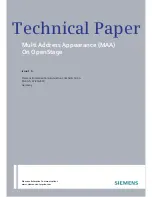
Cisco Wireless IP Phone 8821 and 8821-EX Wireless LAN Deployment Guide
25
It is recommended to have at least two access points on non-overlapping channels with at least -67 dBm signal with the 25 dB
SNR to provide redundancy.
To achieve maximum capacity and throughput, the wireless LAN should be designed to 24 Mbps. Higher data rates can
optionally be enabled for other applications other than voice only that can take advantage of these higher data rates.
Recommended to set the minimum data rate to 11 Mbps or 12 Mbps for 2.4 GHz (dependent upon 802.11b client support
policy) and 12 Mbps for 5 GHz, which should also be the only rate configured as a mandatory / basic rate.
In some environments, 6 Mbps may need to be enabled as a mandatory / basic rate.
Due to the above requirements, a single channel plan should not be deployed.
When designing the placement of access points, be sure that all key areas have adequate coverage (signal).
Typical wireless LAN deployments for data only applications do not provide coverage for some areas where VoWLAN service
is necessary such as elevators, stairways, and outside corridors.
Microwave ovens, 2.4 GHz cordless phones, Bluetooth devices, or other electronic equipment operating in the 2.4 GHz band
will interfere with the Wireless LAN.
Microwave ovens operate on 2450 MHz, which is between channels 8 and 9 of 802.11b/g/n. Some microwaves are shielded
more than others and that shielding reduces the spread of the energy. Microwave energy can impact channel 11, and some
microwaves can affect the entire frequency range (channels 1 through 11). To avoid microwave interference, select channel 1
for use with access points that are located near microwaves.
Most microwave ovens, Bluetooth, and frequency hopping devices do not have the same effect on the 5 GHz frequency. The
802.11a/n/ac technology provides more non-overlapping channels and typically lower initial RF utilization. For voice
deployments, it is suggested to use 802.11a/n/ac for voice and use 802.11b/g/n for data.
However there are products that also utilize the non-licensed 5 GHz frequency (e.g. 5.8 GHz cordless phones, which can impact
UNII-3 channels).
Summary of Contents for 8821
Page 54: ...Cisco Wireless IP Phone 8821 and 8821 EX Wireless LAN Deployment Guide 54 ...
Page 69: ...Cisco Wireless IP Phone 8821 and 8821 EX Wireless LAN Deployment Guide 69 ...
Page 70: ...Cisco Wireless IP Phone 8821 and 8821 EX Wireless LAN Deployment Guide 70 ...
Page 71: ...Cisco Wireless IP Phone 8821 and 8821 EX Wireless LAN Deployment Guide 71 ...
Page 85: ...Cisco Wireless IP Phone 8821 and 8821 EX Wireless LAN Deployment Guide 85 ...
Page 88: ...Cisco Wireless IP Phone 8821 and 8821 EX Wireless LAN Deployment Guide 88 ...
Page 112: ...Cisco Wireless IP Phone 8821 and 8821 EX Wireless LAN Deployment Guide 112 ...
Page 158: ...Cisco Wireless IP Phone 8821 and 8821 EX Wireless LAN Deployment Guide 158 Select Install ...
Page 172: ...Cisco Wireless IP Phone 8821 and 8821 EX Wireless LAN Deployment Guide 172 ...
















































